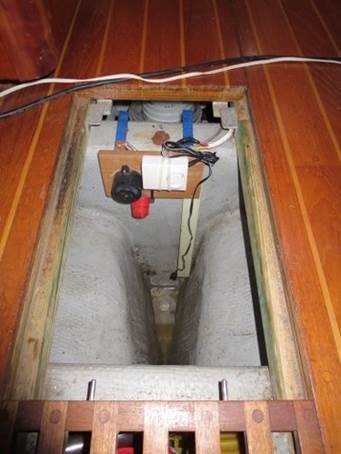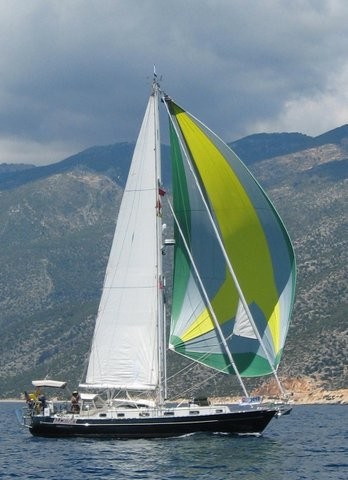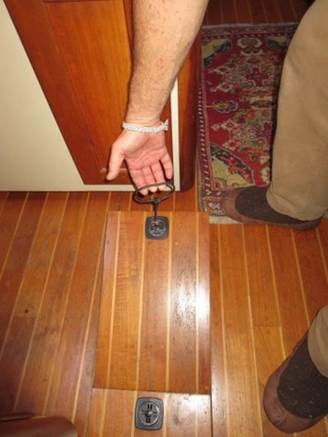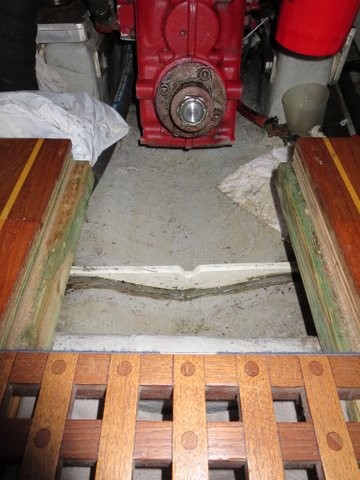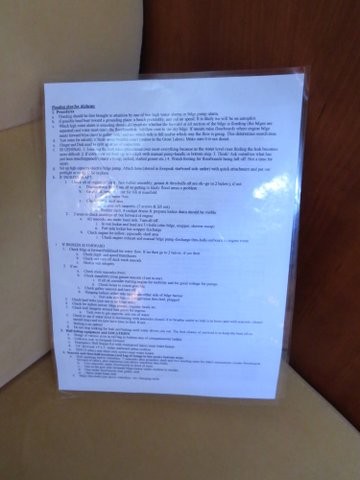By Dick Stevenson
Copyright March 2014
Dick and Ginger Stevenson’s Valiant 42, Alchemy, underway off the coast of Turkey.
A strategy for managing a flooding situation aboard your vessel.
By flooding I mean any ingress of water which is unable to be stemmed by pumps: i.e. you are sinking. A planned and practiced strategy is crucial as flooding calls for specific directed actions,quickly executed.
I am primarily addressing the typical cruising boat, a husband/wife team on any size boat, although much of the planning can easily be considered for fully crewed vessels. Even if you often have guests, they are unlikely to be helpful in a situation where quick, practised actionis necessary.
The Synopsis of this Strategy
The bottom line in a flooding situation isthe need to find the flooding and find it fast. As water rises it coversthe leak making what was, at first, an easy visual inspection, turn quickly into one done by Braille: by feeling around. Clearly, visual inspection is far quicker and surer. Most of what I suggest is to allow the leak to be found fast.
As a general rule, most of us get less competent in emergencies. Obvious alternatives are not thought of in the anxiety of the moment. Planning ahead, making diagrams and, most important,practicing will mitigate this tendency.
1. Setup your boat to allow you to quickly find and respond to leaks.
a. Anticipate vulnerabilities: First, know your boat and try to anticipate all possible areas of vulnerability to flooding.Make a diagram with salient points highlighted.
i. Make sure all seacocks are accessible and able to be worked by your least strong crew. If there is a seacock which is largely inaccessible, say only by taking apart woodwork or by emptying a locker, consider access cut-outs or re-thinking your storage. Relocating that seacock is not an unreasonable choice, either.
1. Labelling seacock locations on a cabinet,hatch, or floorboards can help, especially those vessels with many thru hulls.
ii. Include rudder, prop shaft, and transducers as areas for flooding potential as well.
iii. Track all your hoses, especially those from seacocks. You will find chafe points you can protect, and you can anticipate vulnerable areas such as distribution manifolds.
iv. You cannot do much about your vessel’s bilge sump, but one should keep in mind that the less sump you have, the less warning you will receive and the more quickly water will cover and obscure wide areas.
v. The same goes for structural “pans” or “liners”, they can obscure hull inspections and direct water in difficult to predict pathways.
b. Early notice: high water alarms* are absolutely essential as they can give immediate warning of any unusual water accumulation. They must be able to be heard in the cockpit of, or anywhere aboard, any type of boat when closed up with the engine running. Many a crew has first found flooding by discovering their floorboards afloat. If we have heard that story told, the crew was generally very lucky. I suspect many who found their floorboards afloat weren’t fortunate enough torelate a tale from which others might learn.
The high water alarm (white box), 9v battery operated, with sensor at end of black wire going down deep into bilge for early warning, is visible in this image. Also shown is a buzzer (black)indicating electric bilge pump activation and a secondary sensor (orange) to detect propane fumes.
i. One option is an alarm which sounds every time the electric bilge pump operates from its float switch. We have a dry boat, so pump activation is always motivation for bilge inspection. At the very least, a conspicuous light should illuminate with each pump activation.
ii. Another option (and there is no reason not to do both) is a dedicated high water alarm ready to go off when water gets just a scooch higher (no more than 2 inches) than the level where your bilge pump activates.
iii. If you have two or more bilges it helps when the alarm sounds are distinct for each bilge, this way you have an early indication for a search area. Alternatively,you could have an alarm panel that includes a light denoting different bilgeareas.
c. Floorboards:the crucial floorboards for inspection must be able to be removed quickly by the weakest member of the crew.
i. After a period of high humidity, make sure your floorboards are not too swollen to remove. Shave them if necessary.
ii. Review all floorboards that need to be lifted for a complete flooding inspection. If screwed down, refit to a floorboard lock that is quickly released (as a distant second best, store a charged electric screwdriver ready at hand – Phillips or Robertson square head fasteners only).
Alchemy’s locking floorboards were occasionally tough to open by finger pull, so we had a blacksmith execute this simple handle.
d. Speed:the quicker the leak can be isolated, the narrower the search area.
i. Some boats have the engine area bilges separated from the living area bilges. A quick look determines which area is flooding and narrows the search area.
1. Make separate diagrams to show which seacocks,transducers, etc. drain into which bilge area. This is not always obvious,especially with structural pans. One way to clarify is to pour a glass of water near a seacock and track where the water goes.
ii. If you have a “one bilge” boat, consider a dam at a strategic point. It does nothave to be high or strong: just a water stopper. Water can and should spill over, but make it high enough to allow alarming it to narrow the search area. **
e. Pumps:the more water that can be removed from the boat automatically, the more time to find the leak when it is most easily found.
i. This means electric bilge pumps for most of us.
1. Pumps benefit from clean bilges, flushed regularly.
2. They also benefit from good voltage and unrestricted amperage. Review, check and/or upgrade your wiring.
ii. It also means that manual bilge pumps have no place in this strategy (manual bilge pumps always have a place on a boat: for fully crewed boats to utilize manpower while others look, as redundancy to electric pumps and to meet regulations):***
1. They are a dangerous distraction from the main goal of finding the leak and finding it fast.
2. Most cockpit mounted pumps (with their short12 inch handle) move only a moderate amount of water and are hard to sustain energetically.
3. A big pump like an Edson with a 3 foot handle is a wonderful piece of kit, but is still not a wise use of manpower. You do not want 50% of your search capacity(2 person crew) pumping when that pumping is quite unlikely to keep up with sustained flooding and the goal is to find the flooding fast. Two people should be searching for the leak.
2. Refine thestrategy for your boat.
a. The alarm indicates flooding. This is one alarm that should get immediate action and the action should be previously thought through and practiced; this is not a timeto be spontaneous. One or two floorboard lifts should indicate whether there is a worry and where to initially concentrate your search.
b. From here each vessel’s detailed flooding procedure plan will start to be unique to its own particular design. I am including Alchemy’s flooding plan (shown below)as a way to address the details, the compromises, and some ancillary considerations for this serious event. The following will show how we havetaken the above strategy and made an operating procedure for our vessel. Each vessel will differ in the details, but generally the principles will pertain.
3. Practice
a. There is no way to emphasis this enough. You cannot just write a plan. You must practice using it to make sure your plan works and you can work the plan.
*Easily obtained high water alarms can be had very inexpensively by any vendor who sells household products. I prefer dedicated (own battery) household type units similar in design to the Swann SW351-WLA while many might like Ultra Safety Systems’ more marine oriented unit with a separate panel. Regardless, they should be tested at regular intervals.
**Often, a natural area for a small dam iswhere the engine room bilge meets the living area bilge. As said, the dam does not have to be high, but an added benefit is that small inevitable spills of oil, diesel, coolant, etc. stay contained and are easier to clean and less likely to be pumped overboard. They also give quick notice of engine drips/leaks.
Illustrating a coffer dam(could be easily alarmed) to warn of/ capture leaks in engine room (also shows early signs of oil/coolant leaks).
***Often articles in magazines reflexively mention manual bilge pumps. I have worried that many boat owners believe going to their manual bilge pumps is a first response to flooding. A casual survey of boat owners seems to confirm this.
A. Procedures to be thought through and practiced in advance.
IS THE BOAT ACTUALLY FLOODING?
1. Flooding should be first brought to attention by a high water alarm or bilge pump alarm.
a. Which high water alarm is sounding should differentiate whether the forward or aft section of the bilge is flooding[the bilges are separated and water must reach the floorboards to fall/flow to the other bilge]. If unsure, raise floorboardswhere engine bilge meets forward bilge (next to galley sink) and see which sideis full and/or which way the flow is going. This determines search area.
2. If you are willing, test water for salinity; if fresh water, breathe easier(unless sailing in fresh water). Make sure it is not diesel (roll between fingers).
IF IT IS FLOODING: Ginger and Dick work through previously-determined areas ofinspection.
1. IN GENERAL:
a. Locating the leak takes precedence over most everything because as the water level rises finding the leak becomes more difficult.
b. If extra crew, set them up in cockpit with manual pump-handle in bottom step.
c. THINK! Ask ourselves what has just been done/happened (heard a bump, tacked, started genset, filledwater tanks etc.)
d. Watch footing for holes left exposed by floorboard removal. Not a time for injury.
e. At some point,earlier rather than later, consider donning life jackets/vests or ensuring they are ready at hand.
f. At some point, again earlier rather than later, reach out to make contact. This could include:
i. Calling out a Pan PanPan and making a report of vessel’s location and the nature of distress.
ii. Hitting the VHFdistress call button (DSC button) and hold for 5 seconds–we can always cancel later.
g. Consider same with EPIRB.
h. Consider heading the boat toward a grounding place, a beach preferably, and put on speed. (It is likely we will be on autopilot and this will entail only a quick turn of a dial.)
i. Consider starting the engine as electric bilge pumps will pump more water with increased voltage.
2. Consider setting up high capacity electric bilge pump (one automatic medium capacity pump is always available). Attach hose (stored in fore peak starboard side under) with quick attachment and put out port light or cockpit. Tie in place. [Note: a plan is in the works for this to be made automatic as this interferes with the primary task of finding the leak.]
IF FLOODING IS IN AFT BILGE AREA:
1. Check aft of engine (if clear, then rudder assembly, genset and thru-hulls aft are ok; go to #3), if water is flowing, then:
a. Turn genset off if itis on, and then turn off water for GS at manifold.
b. If flow stopped, the genset was the problem, if still flowing, then:
2. Check rudder shaft area.
a. Remove starboard lazarette.
b. Rudder shaft, 4 cockpit drains, genset exhaust & propane locker drain should be visible. [On ALCHEMY, there are a number of thru-hulls at or just above the waterline that have no valves (such as the cockpit drains). I consider this a design compromise I am not happy with, but have decided to live with.]
3. Two areas to check midships aft (that go into aft bilge area).
a. Three seacocks are under head sink. Turn all off after inspection.
a. In wet locker and head are 3 thru-hulls just above waterline (electric bilge,scupper, shower sump).
b. Portside locker has scupper discharge and a no longer used, now plugged,refrigeration outlet
b. Check engine area for leaks, especially shaft area.
a. Check engine exhaust and manual bilge pump discharge thru-hulls outboard in engine room.
IF FLOODING IS IN FORWARD BILGE AREA
1. Check bilge at most forward floorboard for water flow
a. If Yes, then:
i. Check and turn off deck wash seacock.
ii. Check depth and speed transducers.
iii. Next is hull integrity.
b. If No:
i. Check main seacocks (two, near mast step).
ii. Check distribution manifold (close genset seacock if not in use).
iii. If all ok consider starting engine for mobility and for good voltage for pumps.
iv. Check likely hose lengths for breaks.
c. Check galley seacock and turn off.
d. Hanging lockers either side may drain either side of bilge barrier.
i. Port side also has old refrigeration thru-hull, plugged.
IF NO SUCCESS, CONSIDER:
1. Checking keel bolts (just one in aft bilge area).
2. Checking for siphon action: bilge pumps, engines, toilet, galley sink, dripless shaft seal bleeding hose, etc.
3. Checking hull integrity around best guess for ingress.
a. Tack over to get opposite side out of water.
4. Checking to see if water level is decreasing with seacocks closed; if so breathe easier as leak is in a hose (and with seacocks closed should stop) and we now have time to find. If not….
5. Bailing is an option!
6. Do not stop lookingfor leak and bailing until water drives you out. The best chance of survival is to keep the boat afloat.
7. At some point, prepare life raft, grab bags, etc. for abandoning ship, then return to searching.
B. Hull holing equipment and LOCATIONS
1. Bungs of various sizes in red bag in bottom step of companion way ladder. (I differ from many by not liking bungs attached to each seacock, although they do have to be very accessible. First, in a flood they may be difficult to untie, see and/or work with if tied to the seacock. They also collect dirt, grime & mold and are continually damp which undermines the swelling expected once banged in place.)
2. Collision mat in forepeak forward
3. Emergency Hull Repair Kit with waterproof epoxy near water heater.
4. 1\4″plywood 14″x 3′ under starboard settee cushion with many other various options.
5. 5200 (2 fresh caulking gun size tubes) and sheet rock screws near water heater.
6. A quite creative suggestion (I suspect from the “old salts” manual) is a lead sheet, pre-perforated, with sheet rock screws.
C. Seacock and thru-hull locations (The bag of bungs is in the bottom companion way step). (In our safety manual, in addition to the above text, there are 2 pages of diagrams, port and starboard side, giving visual indications of where the thru-hulls exist.)
1. Hull openings below waterline: 7seacocks (listed below) plus propeller shaft and two sending units for instruments (under floorboards forward of table).
a. Two seacocks under floorboards in front of mast.
b. One in the port side forepeak bilge locker under cushion in middle.
c. One under floorboards near galley sink.
d. Three under head sink.
2. Numerous hull openings just above the waterline, again see diagrams.
Laminated”Flooding Plan” for Alchemy left in an accessible place with other emergency procedures; regular casual perusal is encouraged.
In conclusion, during a flooding situation, one must find the leak and find itfast. To move quickly and successfully at this likely scary time, the crew must have a strategy that has been practiced thoroughly. This strategy is facilitated by an un-ignorable early warning system for high water, automatic pumping capacity, and intimate knowledge of the boat and its thru-hull openings.But most important is the regular practice of the plan. It should be noted that many important ancillary areas have been left largely neglected, including discussions of boat preparation for flooding prevention (checking hose clampsin a systematic manner), bilge pump design and capacity, gear useful to dealing with a leak (bungs, collision mats, etc.). With some due diligence in those areas(and a little luck) one will likely never find it necessary to execute the above strategy for real.
This article as well as many others on seamanship and safety can be found on the Cruising Club of America’s web site,<ahref=”https: target=”_blank” seamanship_safety.htm”=”” seamanship=”” cruisingclub.org=””>https://cruisingclub.org/seamanship/seamanship_safety.htm.
Dick Stevenson is a retired Clinical Psychologist/Psychoanalyst who, with his wife Ginger, has been living aboard their cutter, Alchemy, a Valiant 42, for more than 12 years. They’ve cruised from Bermuda to Maine with their 3 children, and in 2002 they retired, sold the house, and moved aboard full time. Dick and Ginger have wandered the NW Caribbean, Bahamas, and parts of the eastern Caribbean. Without crew, they crossed the North Atlantic in 2006 with stops in Bermuda and the Azores and spent 4 years in the Mediterranean. More recently, they have spent winters in London while doing the British Isles one season andlast season touching on all Baltic countries on their round trip to St.Petersburg, Russia. Norway beckons this upcoming season. Dick is a member of the Cruising Club of America, The Ocean Cruising Club and a Commodore of the Seven Seas Cruising Association, holds a Captain’s license, USCG, and is an Amateur Radio operator, call sign KC2HKW.
For more information on the services provided by Steve D’Antonio Marine Consulting, Inc. please e mail Steve at info@stevedmarineconsulting.com
or call 804-776-0981

